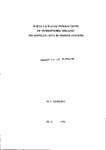PARTICLE-WATER INTERACTIONS OF HYDROPHOBIC ORGANIC MICROPOLLUTANTS IN MARINE SYSTEMS
| dc.contributor.author | RAWLING, M. CARL | |
| dc.contributor.other | School of Geography, Earth and Environmental Sciences | en_US |
| dc.date.accessioned | 2013-09-24T11:15:03Z | |
| dc.date.available | 2013-09-24T11:15:03Z | |
| dc.date.issued | 1998 | |
| dc.identifier | NOT AVAILABLE | en_US |
| dc.identifier.uri | http://hdl.handle.net/10026.1/1926 | |
| dc.description.abstract |
An understanding of the reactivity of hydrophobic organic micropollutants (HOMs) is of paramount importance to water quality managers because of their toxicity, persistence, and liability to bioaccumulate. In this study, the role played by the main estuarine variables (organic matter, suspended particulate matter [SPM], particle type and salinity) on HOM behaviour was investigated by employing samples from estuaries with different geochemical signatures (Chupa, Russia, and the Dart, Plym, Beaulieu and Carnon, U K ) . A laboratory-based technique was developed for the determination of the solubility and sorptive behaviour of HOMs using 14C-labelled, beta-emitting organic compounds (2,2\5,5'-tetrachlorobiphenyl (2,2’5,5'-TCB), bis(2-ethylhexyl)phthalate ester (DEHP), and benzo[a]pyrene (BaP)) coupled with liquid scintillation counting. The results indicate that relative solubility is mainly dependent upon the type of dissolved organic carbon (DOC) present, not its concentration, and is reduced with increasing salinity. The uptake of 2,2’5,5'-TCB and BaP by particles is time dependent with a system response time (the time required to achieve 63% of the new equilibrium) of about 0.37 hours for 2,2',5,5’-TCB and 0.02 hours for BaP. The adsorption, expressed as particle-water partition coefficients, KDS, is to a varying extent dependent on DOC, salinity and particle characteristics (iron/manganese hydroxides, particulate carbon and specific surface area). Adsorption is best defined by a linear isotherm and is enhanced in sea water compared with river water owing to a reduction in charge on particle surfaces at high ionic strengths. This effect has been quantified using an adsorption salting constant, Gp, whose values are typically in the range 0.4-2 L mol-2 The inverse relationship between KD and SPM concentration, an effect well documented in the literature, has been defined by a simple power law (KD = a SPM-b where a and b are site and compound-specific constants). Typical values for a and b are approximately 4x10^ and 0.6 for 2,2',5,5'- TCB, 50x105 and 1.0 for DEHP, and 2x105 and 0.5 for BaP, respectively. Empirical parameterisation of these effects are extremely useful for encoding into numerical transport and distribution models, and their application is demonstrated in this thesis by calculating the retention of HOMs by estuaries. | en_US |
| dc.description.sponsorship | BMT Marine Information Systems Limited Southampton | en_US |
| dc.language.iso | en | en_US |
| dc.publisher | University of Plymouth | en_US |
| dc.title | PARTICLE-WATER INTERACTIONS OF HYDROPHOBIC ORGANIC MICROPOLLUTANTS IN MARINE SYSTEMS | en_US |
| dc.type | Thesis | |
| plymouth.version | Full version | en_US |
| dc.identifier.doi | http://dx.doi.org/10.24382/4435 | |
| dc.identifier.doi | http://dx.doi.org/10.24382/4435 |
Files in this item
This item appears in the following Collection(s)
-
01 Research Theses Main Collection
Research Theses Main


